System, apparatus and method for programmably controlling generation of a notch at a radio frequency using arbitrary pulse pairing
a technology of programmable control and notch, applied in the direction of power conversion system, dc-dc conversion, pulse automatic control, etc., can solve problems such as difficult control of interference in radio frequency (rf) circuits
- Summary
- Abstract
- Description
- Claims
- Application Information
AI Technical Summary
Benefits of technology
Problems solved by technology
Method used
Image
Examples
Embodiment Construction
[0022]In various embodiments, control techniques are provided to reduce or remove interference at RF bands of interest caused by switching of a DC-DC converter. More specifically, embodiments may control PFM control pulses by way of modest timing restrictions, so as to create one or more notches or nulls in a frequency spectrum at a specified frequency or range of frequencies. Specifically in a preferred embodiment, a PFM DC-DC converter is controlled to not output a single pulse of a switching signal, but always to output at least a pair of pulses that have a predetermined delay interval between their start times.
[0023]Referring now to FIG. 1, shown is a schematic diagram of a DC-DC voltage converter in accordance with an embodiment. More specifically as shown in FIG. 1, voltage converter 100 is implemented as a DC-DC switching converter. Converter 100 may be adapted on-chip or off-chip depending upon implementation. To provide a load voltage (VLoad) to a load circuit 130 coupled i...
PUM
 Login to View More
Login to View More Abstract
Description
Claims
Application Information
 Login to View More
Login to View More - R&D
- Intellectual Property
- Life Sciences
- Materials
- Tech Scout
- Unparalleled Data Quality
- Higher Quality Content
- 60% Fewer Hallucinations
Browse by: Latest US Patents, China's latest patents, Technical Efficacy Thesaurus, Application Domain, Technology Topic, Popular Technical Reports.
© 2025 PatSnap. All rights reserved.Legal|Privacy policy|Modern Slavery Act Transparency Statement|Sitemap|About US| Contact US: help@patsnap.com



